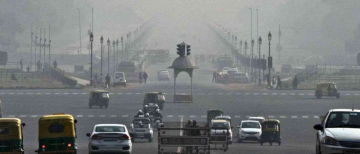In a landmark ruling aimed at curbing the growing menace of dog bites and ensuring public safety, the Supreme Court of India on Friday directed all states and Union territories (UTs) to remove stray dogs from sensitive public spaces such as schools, colleges, hospitals, bus stands, railway stations, and other heavily frequented areas.
The apex court also ordered that these animals be relocated to designated dog shelters after vaccination and sterilisation in accordance with the Animal Birth Control (ABC) Rules. The directive, issued by a bench comprising Justices Vikram Nath, Sandeep Mehta, and NV Anjaria, marks one of the most sweeping interventions by the judiciary to address the escalating issue of stray dog attacks and rabies cases across India.

Stray Dogs to Be Relocated, Not Released Back
The court was categorical in stating that stray dogs once removed from these areas must not be released back into the same locations. The justices underscored that such an act would “frustrate the very purpose of liberating such institutions from the presence of stray dogs.”
The bench also directed that public places be fenced to prevent the entry of stray dogs, adding that it was the duty of local self-government bodies to ensure proper capture, sterilisation, vaccination, and relocation of these animals to shelters.
Timeline and Next Steps
Authorities have been given eight weeks to comply with the order and begin the process of relocation and fencing. The matter will next be heard on January 13, by which time the states are expected to file status reports detailing the mechanisms they have put in place to implement the directives.
The Supreme Court’s directions came during the ongoing suo motu case on stray dogs, initiated on July 28 following widespread reports of rabies-related deaths, especially among children, in the national capital and other regions.

Court Expands Case Nationwide
Originally limited to Delhi-NCR, the Supreme Court had earlier expanded the scope of the case to cover all states and Union territories. The bench said that the stray dog menace was no longer a regional problem but a nationwide concern, demanding coordinated policy enforcement.
On August 22, the top court had already instructed all states and UTs to comply with the Animal Birth Control Rules and submit their progress. However, during the October 27 hearing, the court rebuked multiple state governments for failing to file compliance affidavits.
At that time, the court noted that only West Bengal, Telangana, and the Municipal Corporation of Delhi (MCD) had submitted reports. The bench observed that India’s global image was suffering due to the unchecked stray dog problem. “Didn’t the officers read newspapers or social media?” Justice Vikram Nath had remarked, demanding accountability from top bureaucrats.
Subsequently, the Supreme Court directed the chief secretaries of all remaining states and UTs to appear before it on November 3 to explain their non-compliance.
Apex Court’s Observations and Interim Orders
During the hearings, the bench acknowledged an “alarming rise in dog bite incidents” across India. It expressed concern that both public and private institutions, including hospitals and schools, were witnessing frequent cases of stray dogs attacking individuals, including children and patients.
The Supreme Court has now ordered that local bodies conduct regular inspections to ensure that no new feeding zones or stray dog colonies emerge within institutional or public premises. Moreover, it has mandated that each such location must have a nodal officer responsible for surveillance and enforcement.
These officers, along with municipal authorities and panchayats, are required to conduct periodic inspections for at least three months and report their findings to the court.
_1762502204.jpg)
Directive Also Covers Stray Cattle and Animals on Highways
In a parallel set of orders, the Supreme Court turned its attention to the increasing number of stray cattle and other animals on highways, expressways, and major roads.
The bench directed the National Highways Authority of India (NHAI) and state governments to jointly identify stretches of highways where stray animals are frequently found and remove them to designated shelters such as goshalas.
“All national highways will have helpline numbers for reporting stray cattle,” the court stated, instructing the chief secretaries of all states to ensure strict and immediate compliance.
Additionally, the court ordered the formation of dedicated highway patrol teams to capture stray cattle and ensure they are shifted to shelters where proper care is provided. The justices emphasized that officers would be held personally responsible for any lapses in implementation.
Background: The Suo Motu Case on Stray Dogs
The Supreme Court’s intervention stems from its suo motu case initiated on July 28, after media reports highlighted multiple incidents of fatal dog bites leading to rabies infections, particularly among children.
Earlier, on August 11, the top court had directed authorities in Delhi-NCR to shift stray dogs to shelters. However, it later modified the order, allowing the release of dogs after sterilisation and immunisation — except for those infected or suspected to be infected with rabies and those showing aggressive behaviour.
The court had also called for designated feeding zones, clearly demarcated by municipal authorities, warning that public feeding of stray dogs would invite strict action.
However, the persistent surge in attacks — many of them fatal — prompted the court to take a more stringent stand in its latest ruling.
Supreme Court’s Recent Observations and Concerns
During the hearing on November 3, the court remarked that it would issue interim directions to address the “grave menace” posed by stray dogs in institutional areas, where employees were reportedly feeding and encouraging the canines.
Advocates Anand Grover and Karuna Nundy, who appeared in the matter, urged the bench to consider their submissions before finalising the order. Nundy warned that if dogs were removed, new dogs might occupy the same spots, potentially defeating the purpose of relocation.
However, Justice Sandeep Mehta made it clear that the directions had already been finalised and would stand as issued.
The bench also stressed that fencing public institutions was essential to prevent the re-entry of stray dogs. All educational institutions, hospitals, railway stations, and sports complexes must now be fenced adequately to ensure safety and hygiene.

Accountability and Compliance Mechanisms
To ensure nationwide enforcement, the Supreme Court has mandated the appointment of nodal officers, periodic inspection drives, and submission of status reports within eight weeks.
Each state’s chief secretary is responsible for the effective implementation of the directives. The bench has explicitly stated that any officer failing to comply will be held personally accountable.
The Animal Welfare Board of India (AWBI) has also been made a party to the proceedings to ensure coordination and monitoring of shelter standards, sterilisation, and vaccination processes.
A Strong Message on Public Safety and Animal Welfare
While the court’s orders focus heavily on public safety, the justices underscored the importance of humane treatment of stray animals. The directive requires that dogs be sterilised, vaccinated, and relocated to safe and well-maintained shelters, rather than subjected to cruelty or abandonment.
This approach, the bench noted, aims to balance public health concerns with animal welfare obligations. It also aligns with the broader framework of the Animal Birth Control (ABC) Rules, which mandate scientific population control through sterilisation and vaccination rather than culling.
The Road Ahead
The upcoming hearing on January 13 will be crucial in assessing whether states have acted upon the Supreme Court’s instructions. The bench is expected to review the status reports, inspect the compliance mechanisms, and possibly issue further directions if lapses are detected.
With this order, the Supreme Court has made it clear that public safety cannot be compromised and that both stray dogs and cattle must be managed under a structured, humane, and accountable framework.
With inputs from agencies
Image Source: Multiple agencies
© Copyright 2025. All Rights Reserved. Powered by Vygr Media.
























